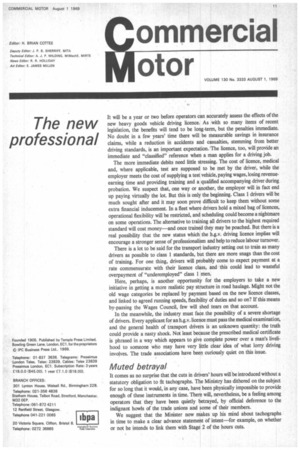The new professional
Page 13

If you've noticed an error in this article please click here to report it so we can fix it.
It will be a year or two before operators can accurately assess the effects of the new heavy goods vehicle driving licence. As with so many items of recent legislation, the benefits will tend to be long-term, but the penalties immediate. No doubt in a few years' time there will be measurable savings in insurance claims, while a reduction in accidents and casualties, stemming from better driving standards, is an important expectation. The licence, too, will provide an immediate and "classified" reference when a man applies for a driving job.
The more immediate debits need little stressing. The cost of licence, medical and, where applicable, test are supposed to be met by the driver, while the employer meets the cost of supplying a test vehicle, paying wages, losing revenueearning time and providing training and a qualified accompanying driver during probation. We suspect that, one way or another, the employer will in fact end up paying virtually the lot. But this is only the beginning. Class 1 drivers will be much sought after and it may soon prove difficult to keep them without some extra financial inducement. In a fleet where drivers hold a mixed bag of licences, operational flexibility will be restricted, and scheduling could become a nightmare on some operations. The alternative to training all drivers to the highest required standard will cost money—and once trained they may be poached. But there is a real possibility that the new status which the h.g.v. driving licence implies will encourage a stronger sense of professionalism and help to reduce labour turnover.
There is a lot to be said for the transport industry setting out to train as many drivers as possible to class 1 standards, but there are more snags than the cost of training. For one thing, drivers will probably come to expect payment at a rate commensurate with their licence class, and this could lead to wasteful overpayment of "underemployed" class 1 men.
Here, perhaps, is another opportunity for the employers to take a new initiative in getting a more realistic pay structure in road haulage. Might not the old wage categories be replaced by payment based on the new licence classes, and linked to agreed running speeds, flexibility of duties and so on? If this means by-passing the Wages Council, few will shed tears on that account.
In the meanwhile, the industry must face the possibility of a severe shortage of drivers. Every applicant for an h.g.v. licence must pass the medical examination, and the general health of transport drivers is an unknown quantity: the truth could provide a nasty shock. Not least because the prescribed medical certificate is phrased in a way which appears to give complete power over a man's livelihood to someone who may have very little clear idea of what lorry driving involves. The trade associations have been curiously quiet on this issue.
Muted betrayal
It comes as no surprise that the cuts in drivers' hours will be introduced without a statutory obligation to fit tachographs. The Ministry has dithered on the subject for so long that it would, in any case, have been physically impossible to provide enough of these instruments in time. There will, nevertheless, be a feeling among operators that they have been quietly betrayed, by official deference to the indignant howls of the trade unions and some of their members.
We suggest that the Minister now makes up his mind about tachographs in time to make a clear advance statement of intent—for example, on whether or not he intends to link them with Stage 2 of the hours cuts.


































































































